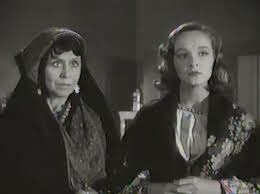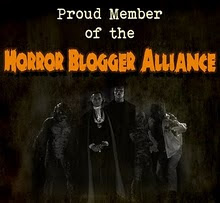Synopsis: Dr. Patrick Cory (Richard Arlen) is a scientist working for Professor Franz Mueller (Erich Von Stroheim) at Mueller's residence / laboratory, a fortress-like place called The Castle. The two are doing experiments on keeping brain tissue alive separate from the body. So far they have only worked with animal test subjects, and while the results have been encouraging things are progressing a little slowly for Dr. Mueller. Like many scientists in these sort of movies, he's obsessed with vindicating his line of research, and he isn't above some ethical monkeyshines to get things moving. More than anything, he wants to test his procedure on a human brain, though the chances of his getting an opportunity to do so seem remote.
Cory and Mueller's assistant Janice Farrell (Vera Ralston) have fallen in love, but unbeknownst to them, Mueller has a yen for Janice himself. Janice and Cory talk of leaving the Castle and running off together, but Mueller excels at manipulating others, and he manages to keep them both on hand and under his control.
One evening a private plane crashes nearby and Mueller transports a critically injured man back to the Castle. He calls Cory back from his date in town with Janice and bullies both of them into assisting him.
The patient dies, and Mueller sees his chance. He removes the man's brain and puts it in a solution of brine; soon, he and Cory are able to verify that the brain is still alive independent of its body.
Mueller and Cory learn that the man who died in the crash was a powerful industrialist named W. H. Donovan. When the coroner comes to the house Mueller tells him that Donovan had suffered a severe head injury and that he and Cory had operated in hopes of saving his life. However, the absence of a brain in the man's head is difficult to conceal and even more difficult to explain, and Mueller employs a little sleight-of-hand to get the death certificate signed and the body taken away.
As the brain marinates Mueller predicts that this is the dawn of a new age; human minds might be able to be indefinitely preserved after death. The knowledge and wisdom of the ages might be able to be stored and accessed at will. Meanwhile, Cory begins to have strange dreams; he can hear a voice repeating the name "W. H. Donovan" over and over again. Mueller speculates that the brain, freed from the body and floating in an electrolytic solution, has become more powerful and has made a psychic connection to Cory.
Janice becomes increasingly alarmed by Cory's behavior. With greater and greater frequency, Cory falls into a fugue-like state, acting like another person entirely. Soon she and Dr. Mueller realize that Cory's body is being possessed by Donovan's brain, that he is being forced to act according to Donovan's will. Cory begins traveling into town, withdrawing large sums of cash from various banks under dummy accounts and spending large amounts of money in efforts to get a convicted murderer sprung from prison. But what is Donovan's connection with the man? And -- what will Donovan's brain do in order to keep Cory's body under its control?
Comments: Curt Siodmak scripted a number of successful horror films in the 1940s, most of which we have already seen on Horror Incorporated. But he's probably best known as the author of the bestselling novel Donovan's Brain, first published in 1942. It was adapted for the screen several times, most successfully in a 1953 version starring Lew Ayres (interestingly, the radio anthology series Suspense also did a two-part adaptation in 1943, with Orson Welles playing Cory). The Lady and the Monster was the first attempt to bring it to the screen, and while it isn't as good as the better-known Lew Ayres version, it's not bad.
In this version Cory works for an older and somewhat creepier scientist named Mueller, who is played with teutonic sternness by Eric von Stroheim. There's no clear reason why this character was added. Perhaps it was felt a romantic triangle would provide a human element to the wacky brain-in-a-glass-jar plotline, or that Cory couldn't make the questionable ethical decisions he made in the book and still retain the sympathy of the audience; or maybe the screenwriter reasoned that a disembodied brain bobbing around in an aquarium didn't make the best antagonist.
There are both advantages and disadvantages to this approach. On the minus side it dilutes the story somewhat, and makes Cory, who is supposed to be the protagonist, a less active agent than he is in the novel and in the 1953 version.
On the plus side we get to see Eric von Stroheim in front of the camera, and he's always great to watch. He glowers and murmurs ominously, and adds a good deal of menace to the goings-on at the Castle. But in the end he isn't really necessary. W.H. Donovan -- at least as he's refracted through the brain and into Cory's body -- is antagonist enough, and there is a real sense of mystery and menace surrounding it, enough to set this opus apart from the other poverty-row efforts we've seen recently, all of which seem to involve scientists trying to extend life beyond its normal limits.
The Lady and the Monster is often singled out for ridicule thanks to the presence of Vera Ralston (nee Hruba), a European figure skater whom Republic Pictures head Herbert J. Yates tried to develop as a movie star. The fact that Yates and Ralston were romantically linked shouldn't come as a surprise, especially when you see Ralston act. Like Marion Davies before her, Ralston's conspicuous lack of talent made her something of a punchline in the movie industry; but in fact, while Ralston isn't great, she isn't terrible either. She does not embody an Acquanetta-level amateurishness, but is in fact on a par with a moderately talented but forgettable college thespian. She does all right as Cory's worried girlfriend, but seems somewhat out of her depth as a lab assistant, flailing around in a flustered sort of way every time Dr. Mueller shouts for a gigli saw -- which he does quite a lot.
Night of Terror

Synopsis: A knife-wielding serial killer known as the Maniac is terrorizing the countryside, and the police, led by the clueless Detective Bailey (Matt McHugh) are unable to catch him. Each of the Maniac’s victims is found with a newspaper headline pinned to the body (as befits a Columbia picture, these headlines are in 42-point font, saying things like MANIAC STILL ON THE LOOSE!).
Meanwhile, at the Rinehart mansion, Dr. Arthur Hornsby (George Meeker) is working late on a chemical formula that will place a person in a state of suspended animation. To demonstrate that his formula works, he plans to inject himself with the serum, then have his body placed in a coffin, buried in the backyard, then dug up eight hours later and revived. A number of skeptical scientists will be on hand to witness the experiment.
Hornsby’s experiment is worrisome to his fiancée, Mary Rinehart (Sally Blane), and she is frustrated that he pays more attention to his experiments than to her. In spite of the fact that she and Hornsby are engaged, Mary is being aggressively courted by brash newspaper reporter Tom Hartley (Wallace Ford) , who is covering the Maniac killings. While Mary chides Hartley about his advances, it’s clear that she is flattered by the attention – attention she isn’t getting from Hornsby.
The servants at the Rinehart estate are as quirky as its other inhabitants. Ethnically indeterminate butler Degar (Bela Lugosi) seems to be carefully guarding a secret or two, and mystical maid Sika (Mary Frey) believes that various omens from the spirit world are pointing toward ghastly fates for all in the Rinehart household.
When family patriarch Richard dies under mysterious circumstances, the will reveals that everyone in the household -- including the servants -- shares in the inheritance. What's more, should any of the inheritors die, that portion of the estate will devolve to the others. So when members of the Rinehart family start to turn up dead, the question is obvious: are they victims of the Maniac, or each other?
Comments: Night of Terror has proven to be something of a second-feature staple on Horror Incorporated. I don't imagine it gets seen much at all these days; like a lot of titles from this era, it has pretty much dropped from obscurity into oblivion since broadcast TV quit showing old movies. But I see it on a fairly regular basis. To be honest, it's not a film that benefits from repeat viewing.
One of the most puzzling things about this film - indeed, a number of horror films of the 1930s and 1940s -- was the use the studio made of Bela Lugosi. If you look at the poster above, you see Lugosi's face prominently displayed, and his name (BELA "Dracula" LUGOSI) is given top billing. Yet Lugosi is not only in a supporting role, but a fairly small one. As we've noted in the past, he functions as a red herring.
His prominence in the promotional materials seems tacit admission of his status as a bankable star; but the uses to which he's put in movies like this indicate that there was a lack of trust in his ability to actually carry a movie. This is the sort of paradox that provides ammunition to both the pro-Lugosi and anti-Lugosi film writers. And they aren't shy about sniping away at each other.
Universal Horrors, the influential Brunas and Weaver overview of Universal's golden age, never missed an opportunity to skewer Lugosi as a dreadful ham unfettered by any discernible talent. But the authors were at a loss to explain why Lugosi's infrequent starring roles (e.g., Return of the Vampire) kept making money.
I've always been fairly agnostic on the question. Lugosi was unquestionably a ham, but the early sound era favored acting styles that we think of today as overly broad. While he was a fairly limited actor who made poor career decisions, he did have a certain appeal and the studios knew it. Whatever doubts they harbored about Lugosi were in spite of, rather than because of, his performance at the box office.
The truth is, while dollar signs are the big persuader in Hollywood, they don't always overcome personal opinion. That Lugosi's star turns made money no doubt carried some weight, but his films evidently didn't make enough money to burn through the prejudices that were already in place.
William Goldman once observed that in Hollywood, "nobody knows anything". But of course the decision-makers in Hollywood think they know everything. The execs were all certain that Lugosi's films couldn't make money. When they didn't, that was taken as evidence that they were right. And when they did -- well, they just decided not to spend much time thinking about that.






































